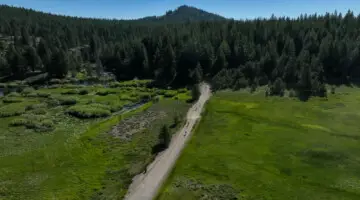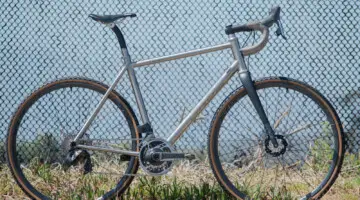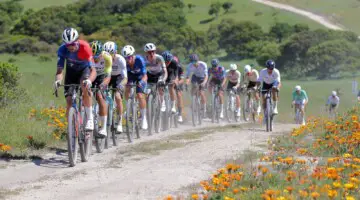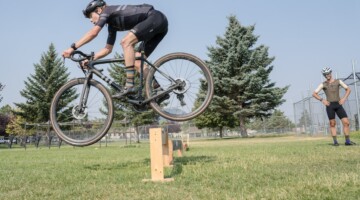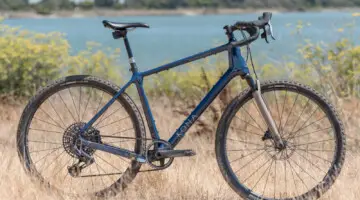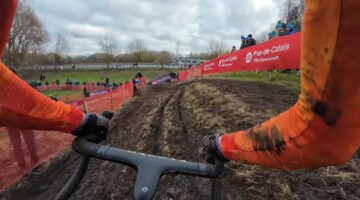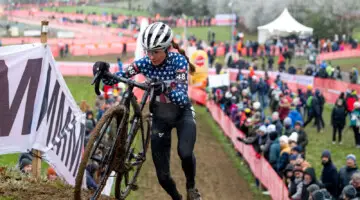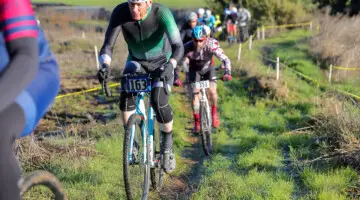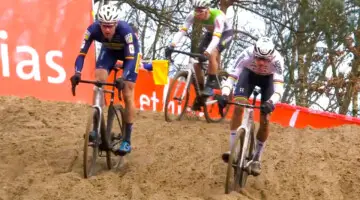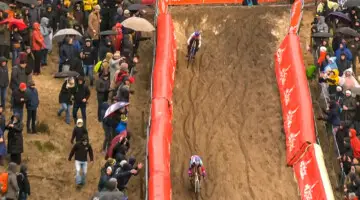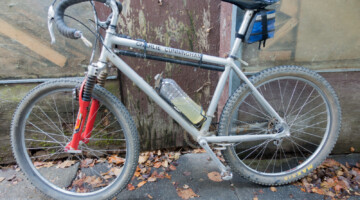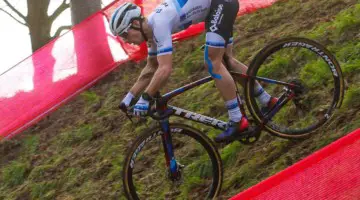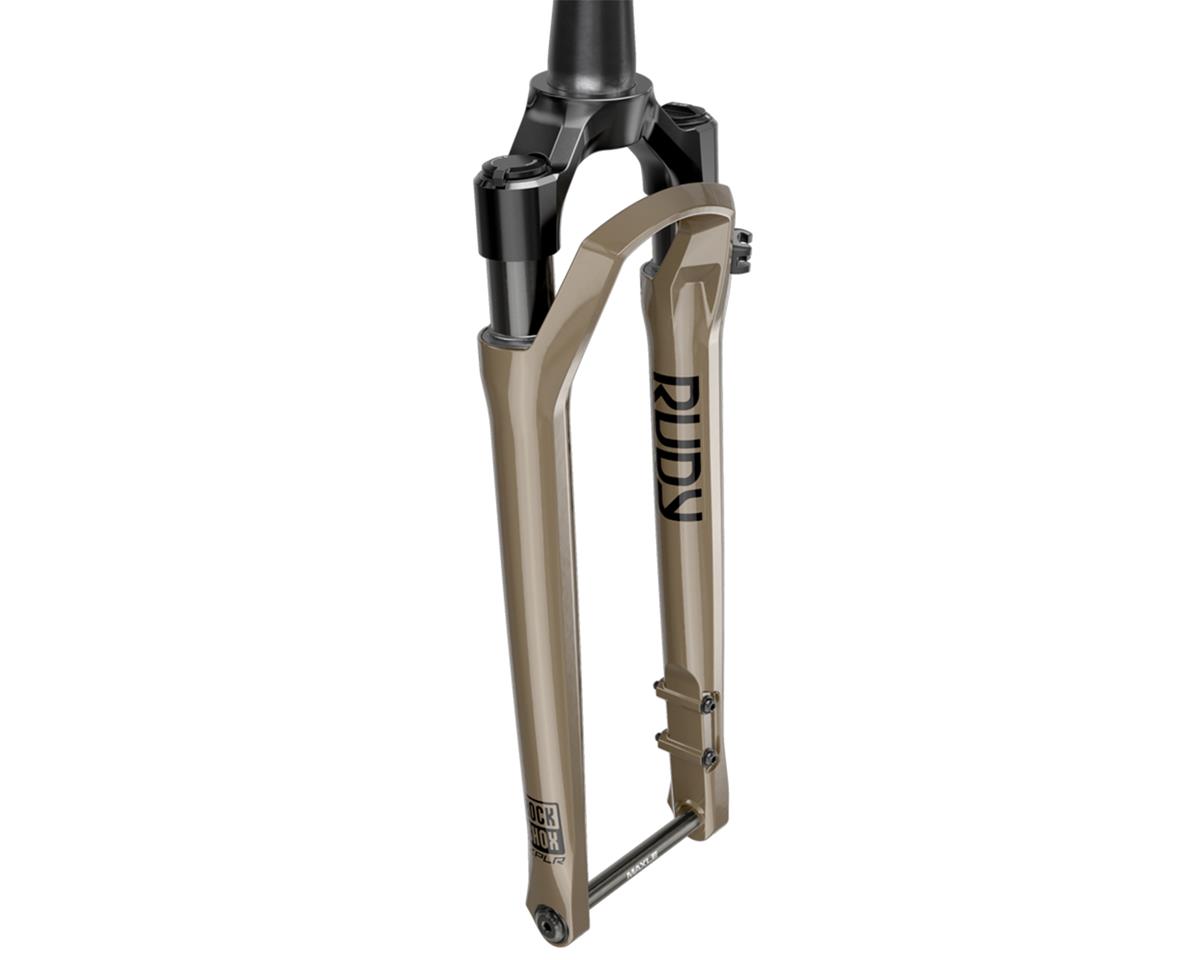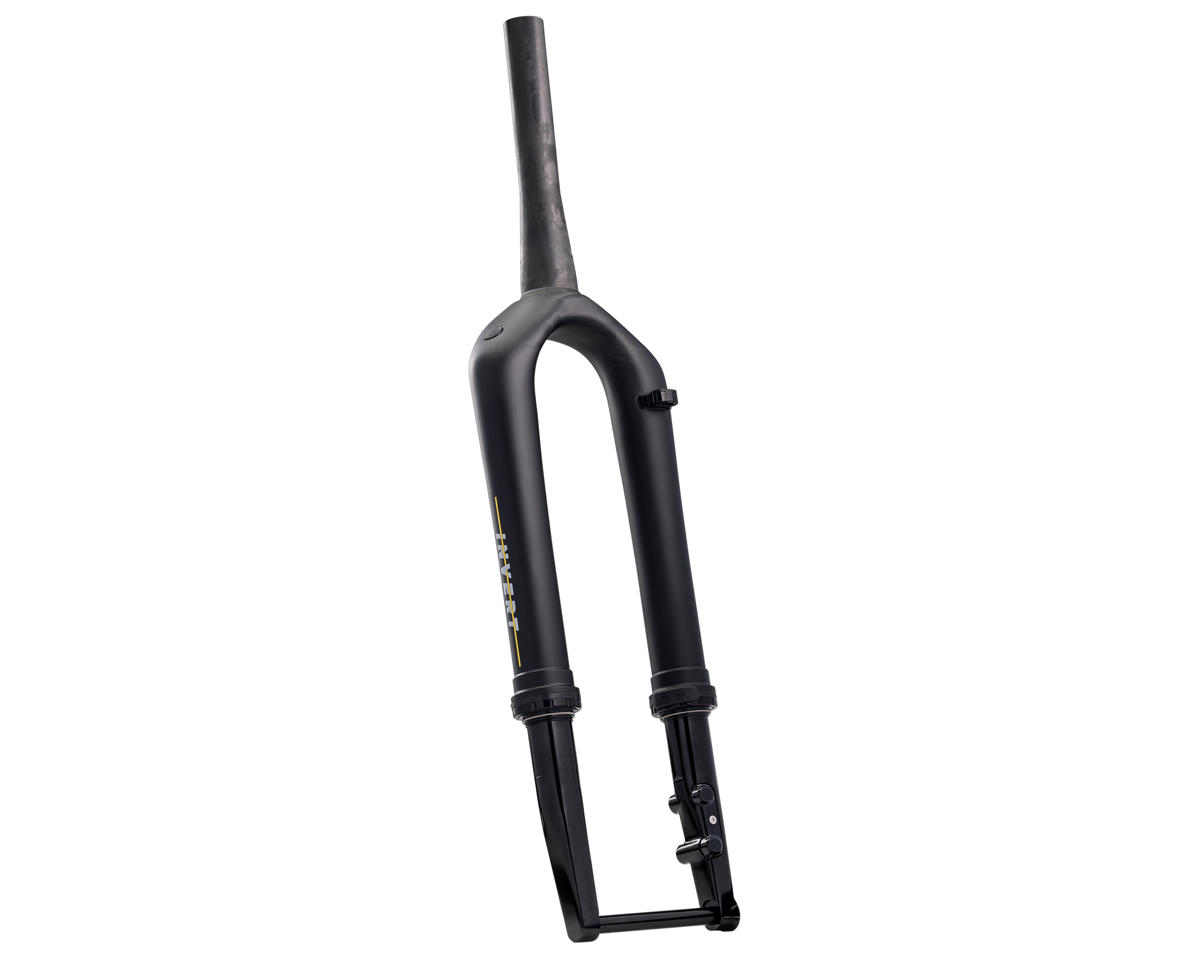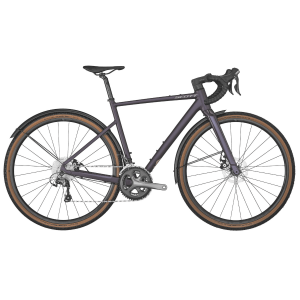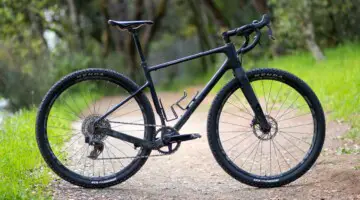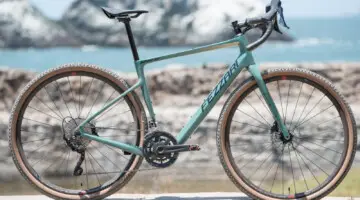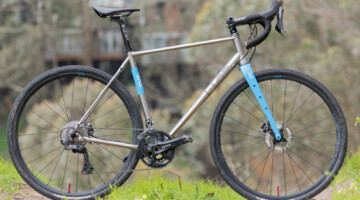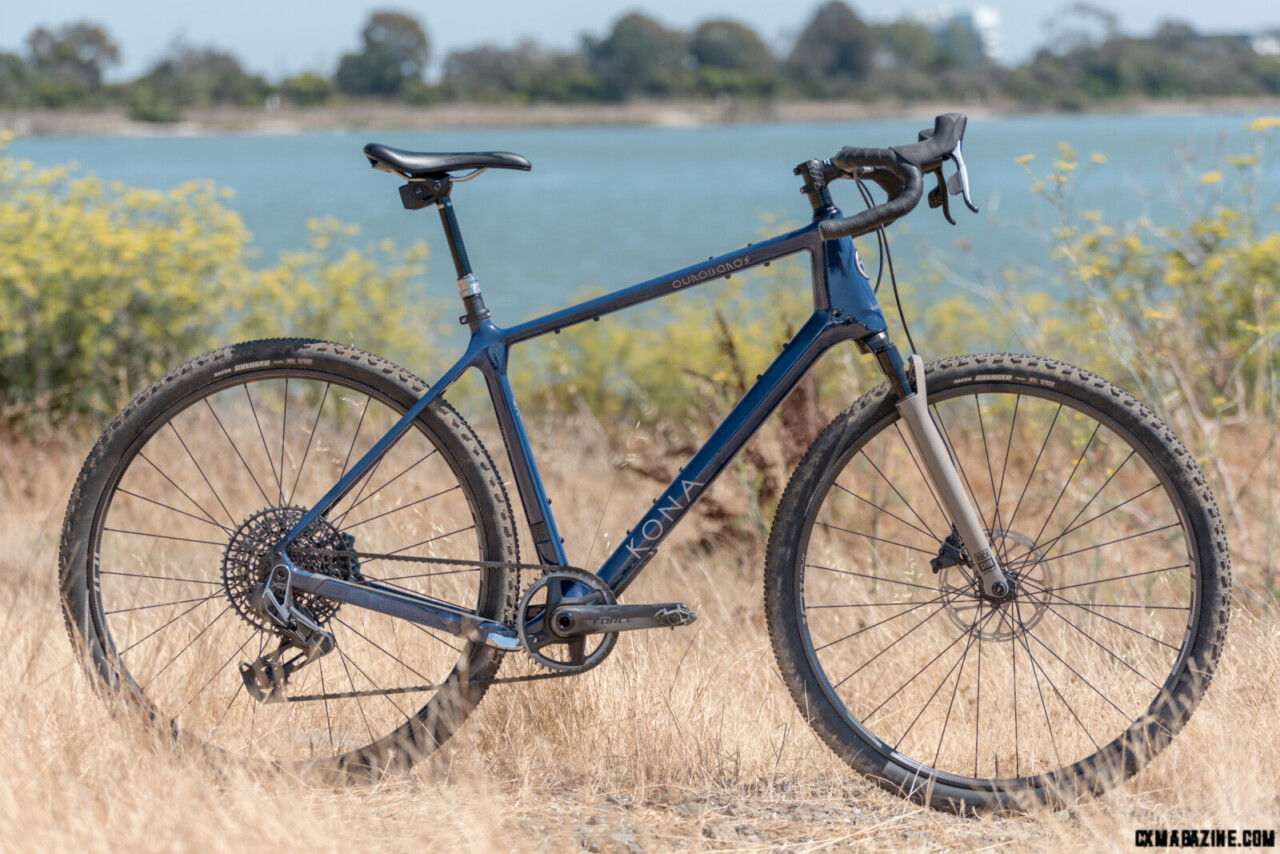
Kona Ouroboros Supreme. ©C. Lee/Cyclocross Magazine
For American cyclocross, Kona is a storied brand. During the era of American Cyclocross popularity from 2003 through 2014, the “twin towers” of Ryan Trebon and Barry Wicks were a dominant force riding Kona Major Jakes. From 1999 to 2005, Ann Knapp ruled American women’s cyclocross aboard a Kona Major Jake. More recently, Clara Honsinger and Kerry Werner raced to victories and National Championships aboard Kona Super Jake cyclocross bikes.
Kona Bikes began in 1988 as a mountain bike brand by Dan Gerhard and Jake Heilbron in Vancouver, British Columbia, Canada with mountain bike legend Joe Murray as product designer. During the pandemic, Kona was sold only to go into demise 3 years later. This year, Gerhard and Heilbron repurchased the company to rescue and revitalize their storied brand.
New Gravel
Over the years, we’ve reviewed the Kona Major Jake both in print and online. I liked the most recent iteration of the bike so much, that I bought the review sample and continue to ride it as my primary ‘cross bike to this day. At the time, the Kona Major Jake was ahead of its time, with increased trail and unofficial 45mm tire clearance. We also reviewed the Kona Libre gravel bike, which is adventure skewed vs. the Major Jake’s race leaning. Sadly, the Major Jake is not currently in the Kona lineup.
The new Ouroboros is a drop bar gravel bike for the rider who wants to push the boundaries of gravel riding toward mountain biking. The idea of drop bars off road is not new. Before mountain bikes, the cyclocross bike took riders off-road. The mountain bike evolved to navigate more challenging off-road terrain, but flat bars prevailed. Charlie Cunningham used drop bars on his mountain bikes, including other innovations still in use today. His early machines from the 1980s and 1990s gained notoriety not only from the innovation but also because those innovations won races piloted by Jacqui Phelan.
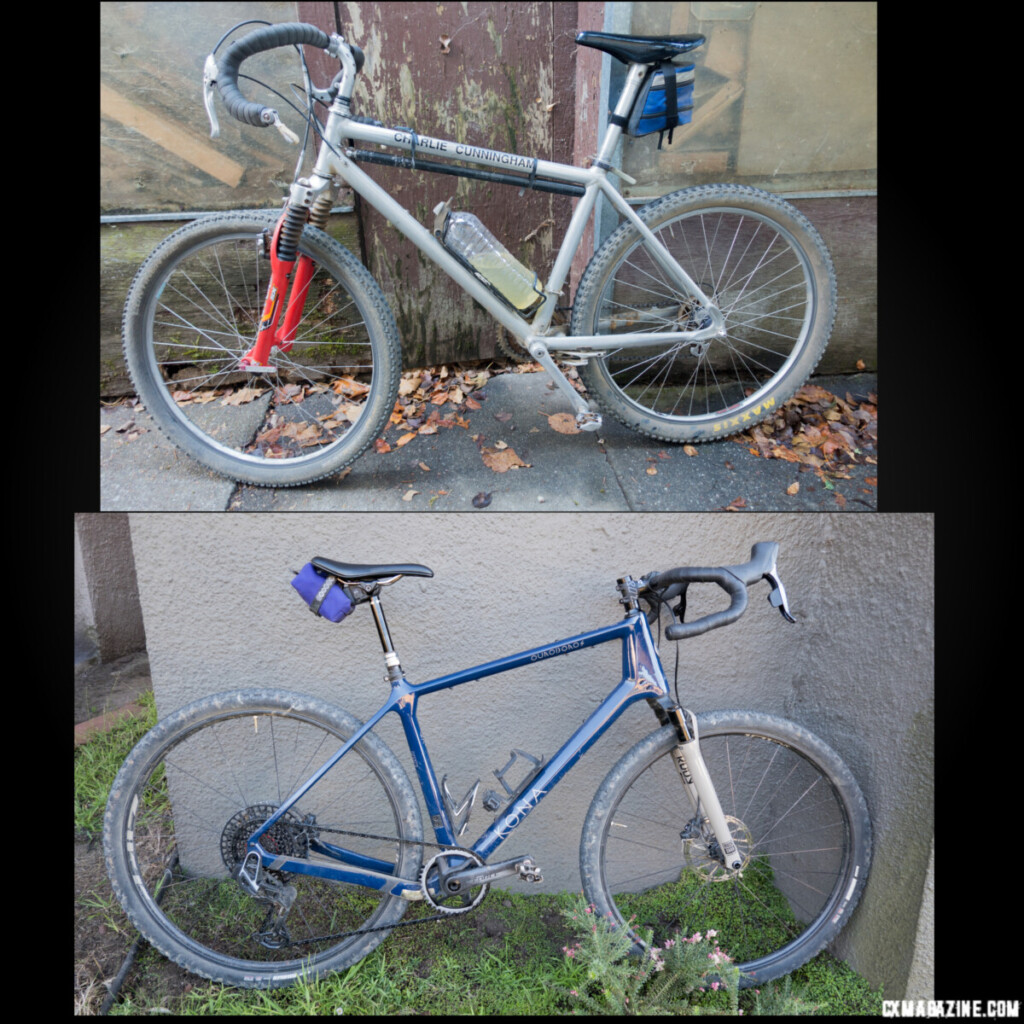
Kona Ouroboros with the original drop bar mountain bike. ©C. Lee/Cyclocross Magazine
The discussion that gravel bike evolution is analogous to early mountain bike evolution is not lost. The Kona Ouroboros represents one of the steps in the gravel bike evolution. Ouroboros is an ancient symbol depicting a serpent devouring its tail. It represents the cycle of destruction and rebirth, appropriate for the Kona bike brand. The Kona Ouroboros is lightweight enough with mild-mannered handling for a pleasant road ride to the trail, even if prolonged. Off-road it has features to increase confidence when riding more technical trails, not the least being the addition of front suspension.
For review, we have the top-end Supreme model from the bike introduction in April 2024, but there are two other models that use the same frame with different builds.
Kona Ouroboros Supreme: The Frame
Three Ouroboros models share the same carbon fiber frame with a reinforced headtube-downtube junction and some reinforcement at the seat collar area. The top tube slopes steeply to offer a more exposed seatpost for dropper travel or seatpost flex to aid compliance. The chainstays drop low behind the Press-fit 86.5 bottom bracket for more space to clear the chainring and tire. The effective chainstay length is 44.5cm across all sizes. The bottom bracket drops 72mm for the 3 larger sizes, and 75mm for the 3 smaller sizes. The frame is set up for flat mount brakes with “road standard” 142 X 12mm through axle rear end with a SRAM UDH.
Size Matters
Our review bike is labeled 56. That number only serves as a rough reference to some road bike size. The seat tube is 50cm tall and the effective top tube length is a rangy 59.3cm. The head tube is 193mm, which is quite tall. The 400mm reach and 610mm stack values are two sizes larger than we would normally pick, but the Kona size recommendations put us between sizes 54 and 56 for the Ouroboros. So with the long reach and high stack, a short stem puts the bars in the right place for reach, but set high. The short seat tube means the top tube slopes a lot, exposing a lot of seat post for maximum dropper travel, or seat post flex for ride compliance.
The geometry splits the difference between road-oriented gravel and cross-country mountain bikes. The headtube angle is 69.5 degrees and yields 82mm of trail (77mm of mechanical trail) with a 700C X 50mm tire and a fork with a 51cm offset such as the 40mm RockShox Rudy XPLR that comes with the Ouroboros Supreme. This is on the long side for a gravel bike, but certainly not in the same range as modern XC mountain bikes with trail figures in the 90mm range. For comparison, a traditional cyclocross bike trail is in the mid-60s. The Fezzari (Ari) Shafer and now elusive Nukeproof Digger are bikes with a greater than 80mm trail measurement, putting them squarely in the middle ground between typical gravel bikes and modern XC mountain bikes and in the same geometry category as the Ouroboros.
The wheelbase is 110.6cm with a fairly long 67.1cm front center. With the rider over the bottom bracket, that puts the front wheel further ahead of the rider than on a typical gravel bike.
If we had sized down to the 54, the stack is 20mm lower and the reach 5mm shorter. I arguably could drop to the Kona Ouroboros 52 if I used effective top tube length, reach, and stack as a guide, but then the bike would yield a different rider experience than you’ll read here. You’ll see that the longer, taller bike with the short stem and wide bars gives the Ouroboros a unique ride.
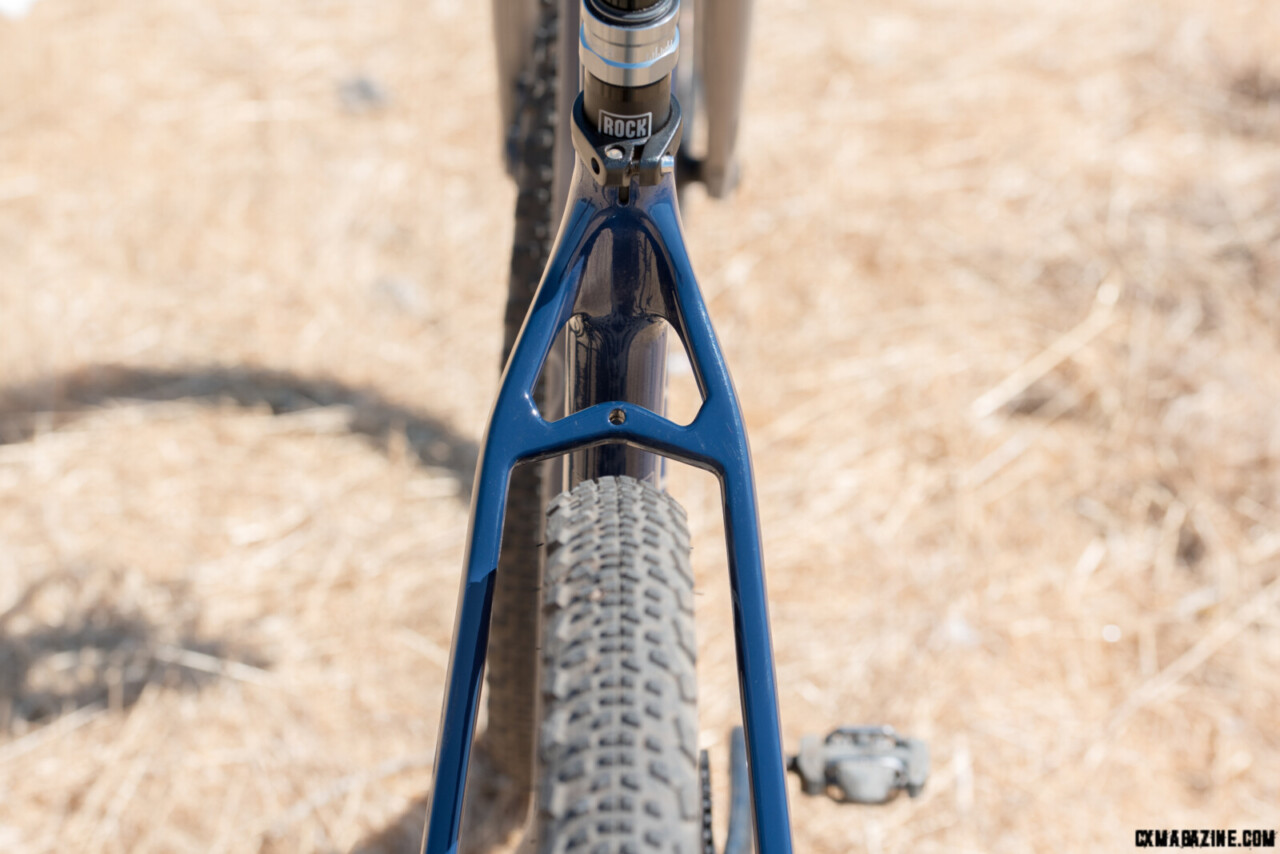
Chainstay bridge to brace the widely spaced seatstays has a fender mount hole. Kona Ouroboros. ©C. Lee/Cyclocross Magazine
There is a guard under the lower downtube to protect the carbon frame from strikes, and a chainstay proctectore as well. The frame is adorned with mounting barnacles including top-tube bag mounts and fender mounts. The RockShox Rudy also has mounting provisions for full-fenders. The downtube has two bottle mounts, the lower one with 3 screws for an extended cage, and the upper set high enough to still accommodate another small bottle. The seat tube has a single bottle set.
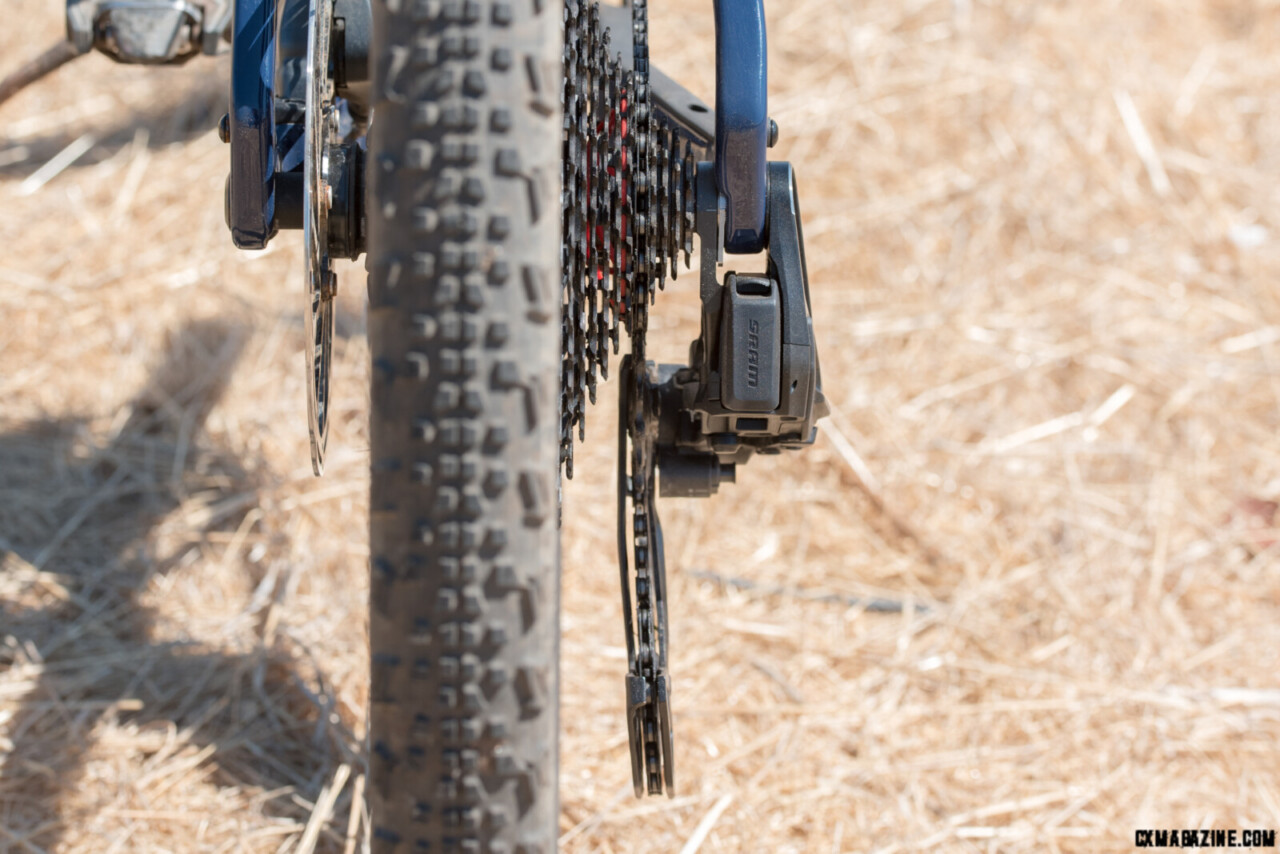
SRAM Transmission mounts on both sides of the rear “dropout”. ©C. Lee/Cyclocross Magazine
Provisions for a front derailleur and cable-actuated derailleurs are present on the Ouroboros frame. All the control lines run internally with entry at the top of the downtube.
Maximum tire clearance is officially 2.1 inches or 53.3mm.
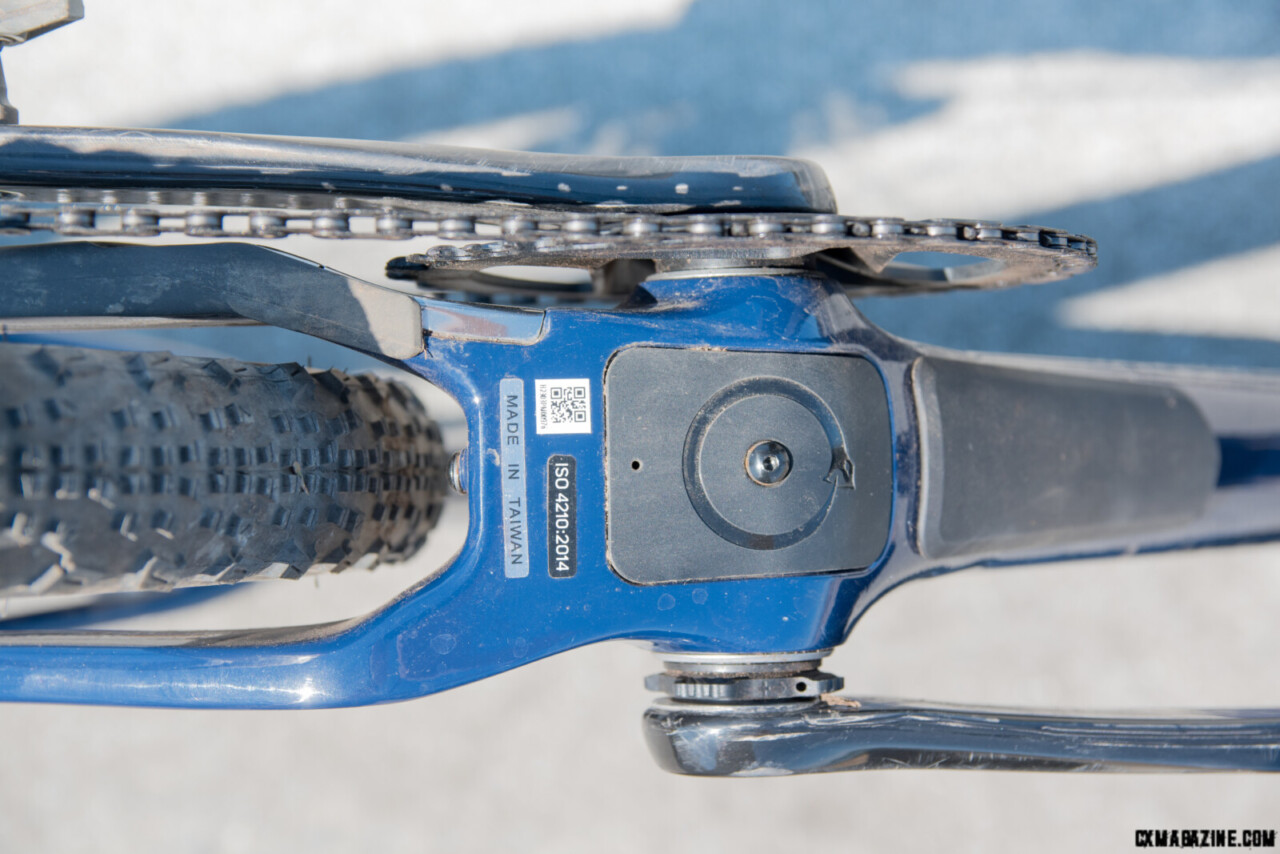
Still room even with a 50mm tire. Kona Ouroboros. ©C. Lee/Cyclocross Magazine
Sprung
The RockShox Rudy Ultimate XPLR 40mm travel fork with the Charger Race Day upgrade is on the Ouroboros Supreme model. A Fox TC 32 Performance 40mm travel fork with a Grip Damper comes on the Ouroboros CR, a complete bike for less than USD 2800, if you can find one in stock! The latter fork has a slightly shorter offset, increasing the trail figure by a few millimeters.
Kona Ouroboros Supreme: The Build
The Ouroboros Supreme is fully SRAM equipped with eTap wireless Force AXS and XO Eagle Transmission. It’s a true mullet setup with Force 1 AXS eTap hydraulic brake/shift levers, and a Force 1 crankset with 175mm arms, a typical pairing for this size bike. A 40-tooth X-Sync direct mount chainring is standard. The brake calipers are SRAM Force for flat mount, a road standard. The rear end has a 10-52 XO Eagle Transmission XD cassette with an XO Transmission flat-top 12-speed chain shifted by an XO Transmission rear mechanism.
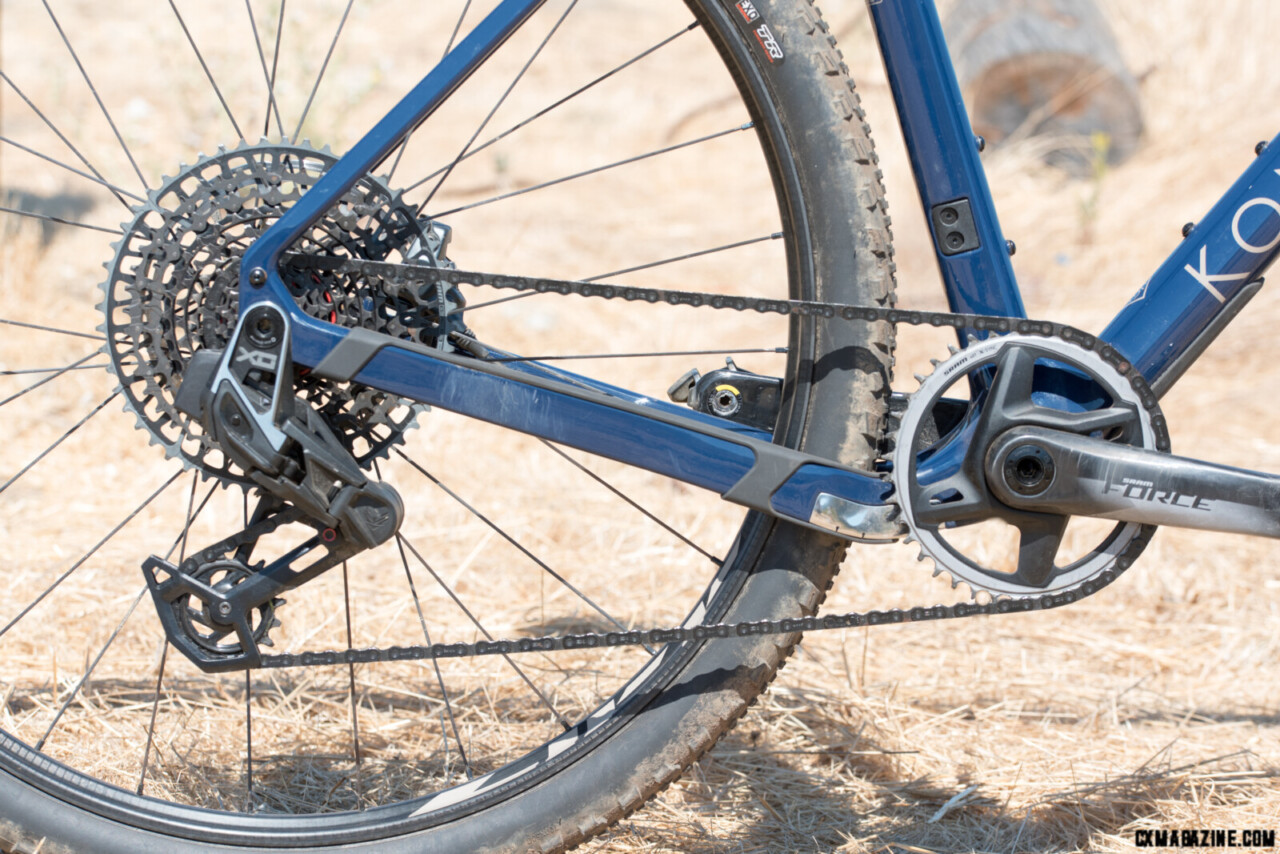
SRAM Force 1 Wide crankset with XO Eagle Transmission rear mechanism. Kona Ouroboros.©C. Lee/Cyclocross Magazine
That gives a 1:0.77 low gear ratio, which is 20.8 gear inches for the old folks. The top gear is 1:4 or 108 gear inches, with plenty of high end when you unleash the sprint or power down that long, steep descent. That 519% spread is more than enough for most riders.
The Ouroboros uses 180mm brake rotors natively in line with its adventure orientation. The Supreme has SRAM Centerline 6 bolt rotors on Zipp 101 XPLR wheels. The Ouroboros Supreme has a RockShox Reverb 31.6mm diameter 125mm travel AXS wireless dropper post to help with riding on adventurous terrain.
Zipp 101 XPLR Wheels
The Zipp 101 XPLR wheels are a unique gravel wheelset. Built around a standard 142 X 12mm rear Zipp ZR1 hub, 28 spokes lace a wide carbon single-wall rim into the wheel. The bladed spokes are interlaced X2, and the rim is 27mm internal width. The single-wall hookless rim has an old-school look, and the single wall means the nipple heads protrude into the rim channel. The wheels on our review bike came with the tires already installed tubeless. To seal the single-wall rims yourself, install a narrow plastic rim strip that covers the exposed nipple heads in the center channel, and then two layers of wide tubeless sealing tape over that. It will be challenging, but certainly doable if you need to retape the rim to seal it for tubeless. Zipp has a video to guide you through it.
The wheels have Maxxis Ravager 700C X 50mm TR EXO tires.
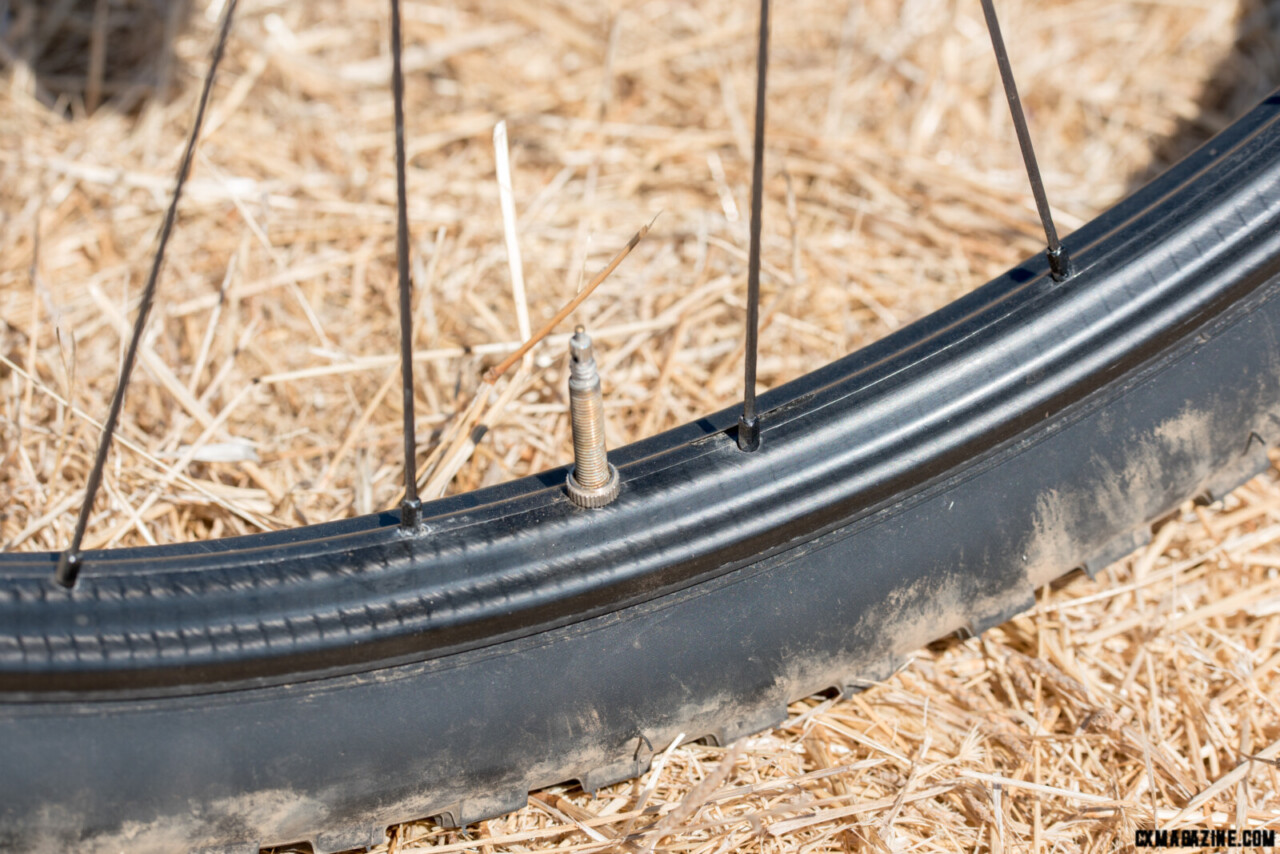
Zipp 101 XPLR single wall carbon rim, 27mm internal width. ©C. Lee/Cyclocross Magazine
Short and Wide
A short 70mm Ritchey Trail WCS stem pairs with the Ritchey Superlogic Venturemax WCS carbon handlebar to the steerer. Our size 56 bike has a 48cm size bar. This carbon drop bar is unique for its width, shallow 102mm drop, 4-degree back sweep, and 24-degree flare. The bar is 48mm at the first bend along the top, 50cm at the brake hoods, and 60cm at the flat drops.

Ritchey WCS Superlogic Venturemax. 50mm at the hoods. Kona Ouroboros. ©C. Lee/Cyclocross Magazine
All together, the Kono Ouroboros Supreme is 23.1 pounds for the size 56 review bike we have. It’s 14.1 pounds without the wheels.
Kona Ouroboros Supreme: The Ride
Our size 56 Ouroboros Supreme review sample has a long reach and high stack. Combined with a short stem, wide bars that have a shallow drop, 40mm of damped front suspension, and a dropper post, this bike put me in a confident position off-road. The bike came with 30mm spacers under the stem, including the 10mm tall top headset cap, which leveled the handlebars with the saddle. The Ritchey Superlogic Venturemax handlebar is the widest drop bar I’ve ridden in a long time. The drop is shallow and the lower section is flat with palm swells. Set up as it is, this bike is meant to be ridden in the drops.
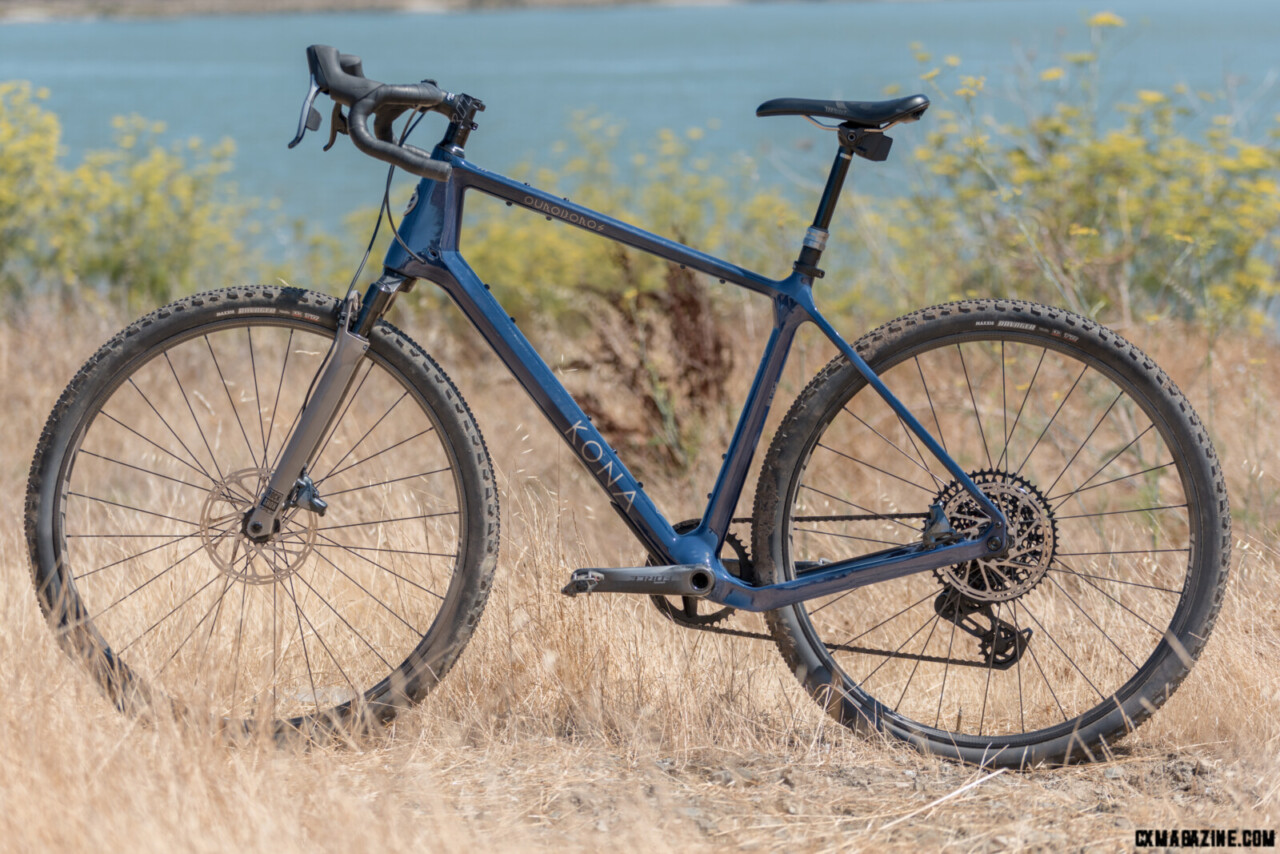
The saddle is level with the top of the handlebars on our review bike. Kona Ouroboros Supreme. ©C. Lee/Cyclocross Magazine
When the trail points steeply down, you feel confident on the Ouroboros as if on a mountain bike. Your weight is not heavily forward and with the dropper down, you can stay low over the bottom bracket. The big tires add traction, and the tread of the Maxxis Ravager is a good combination of knobs for a wide variety of off-piste terrain.
To qualify that, this is still a gravel bike compared to mountain bikes today. I always enjoy the underbiking aspect of riding a cyclocross bike off-road. That said, being in control is arguably more fun and certainly safer. Also, it is proven that smoother is faster.
On the Road Again
Road manners are not extraordinary, but not dull. The Ouroboros does not draw attention with any handling quirks. It is like a touring bike from the days of yore.
The rider position is also touring bike-like, upright with wider bars. If you pump the big tires up and lock the fork out, only the buzzing of the big tires reminds me that I’m on an off-road-oriented bike. The long trail is not noticeable on rambling road rides as the bike follows your desired line with a gentle lean of the bike. Take the Ouroboros on a more aggressive road ride with multiple linked 90-degree turns and sprints out of the corners and it comes out of its element. The Ouroboros requires steering correction that uses physical and mental effort to get through the chicane, and the acceleration is a bit lackadaisical, thanks in part to the big knobby tires.
If you use the dropper post, leaning the bike harder feels more comfortable, but without a berm to lean against, you still need steering input to bring the bike around the turn.
It’s Not a ‘Cross Bike

The Kona Ouroboros in action. Smoother is faster. ©gurufoto/Cyclocross Magazine
Aside from riding the Ouroboros on the usual cyclocross test courses, I raced the Ouroboros in three cyclocross races and a short “dirt classic” race. The cyclocross race courses varied, with dry and dusty early September racing and then a back-to-back race weekend following a rain storm the week before. These local races do not have a tire width restriction in most categories, so running the 50mm tires or front suspension is not an issue.
The biggest demerit is the weight of the bike. On any section that requires lifting the bike, the extra 5 pounds is a burden. Accelerating with the big tires and relatively heavy wheels is also noticeable. The extra-wide Ritchey Adventure Max handlebar is an additional complication on narrow sections where I might clip a post or tree. The long wheelbase and slack front end slow you down on tight-linked turns on a compact course as you must steer the bike a bit if there are no berms to lean on. Undoubtably, a lighter more nimble bike with a higher bottom bracket has the advantage on many cyclocross courses.
The big tires pay back with track-smoothing traction. The 1300-gram (2.9 pounds) fork with 40mm (1.5 inches) of travel is unnecessary but adds front traction over roots and steps on the ‘cross track. I did not have to be as careful with line selection and could stay seated applying power on the bumpy sections of the track. Through wet mud and sand, the big tires float on top. Smoother is faster in many cases.
The Ouroboros is fun to race on the cyclocross course, with some advantages and disadvantages, but it takes away from the underbiking “Spirit of Cyclocross”.
Gravel Racing and Adventure
Gravel racing has no equipment restrictions aside from an aero bars ban at the pointy end of some races. On the bumpy sections of the cyclocross course, it seems smoother is faster, so on the longer courses of gravel where fatigue plays a bigger role, the same is true. At least, smoother is more comfortable and contributes to better control. 50mm is a common gravel racing width and the Ouroboros can go a bit larger than that officially (2.1 inches, or 53.3mm). Much of my gravel riding was with tire pressure at 20 psi or just below, for my 155 pounds.
The Rudy fork is adjustable, has minimal stiction, and has a lock-out. It seems quite active over small gravel beyond what the big tires can absorb. On bigger hits that you might not avoid in the early morning or late afternoon light, it absorbs the sharpness, converting it to a dull thud. I rarely lock the fork unless the climb is long with a lot of standing, or if I am sprinting for the town limit sign.
On these longer off-road or mixed-terrain adventures, bike weight is not a factor. But if there is a lot of elevation change over the course, 5 pounds less for every 1000 feet of climbing would no doubt save some energy.
When the course points downhill, the Ouroboros geometry and suspension pay some dividends.

Smooth on fast descents. The Kona Ouroboros Supreme in action. ©Joshua Posamentier/Cyclocross Magazine
The high stack keeps your body balanced over the pedals as the trail points down. The dropper and wide handlebars aid that. The Ritchey Adventure Max drop is so shallow that, combined with the high stack position, you can comfortably descend in the drops. Some people are more comfortable in that position than others anyway.

The drops are for descending. Jacqui Phelan. ©C. Lee/Cyclocross Magazine
The 1.5 inches of suspension takes the jarring out of small drops when coming down a trail, and on a rough, loose surface, it helps keep the wheels planted.
Why not a Cross-Country Hardtail?
The Ouroboros handles like a gravel bike and is geometry-corrected for a short travel suspension fork. A modern cross-country hardtail is suspension-corrected for a suspension fork with at least twice that amount of travel. Some modern cross-country race bikes break the 23-pound range. A mountain bike typically has a slightly higher stack, a higher bottom bracket (less drop), and a degree slacker head tube angle with a longer front center. This makes the mountain bike less suitable for efficient pavement and fire road riding. There is certainly some overlap, so you have to decide whether you prefer a bike for true mixed terrain, or one primarily for off-road riding.
The Verdict
The Kona Ouroboros is perhaps best for guys like me who like mixed terrain with a lot of off-road riding. The ride starts or finishes with a long road ride before the off-road section. Although these rides have some technical sections, they’re shorter and smaller than where you would take your mountain bike. The rider position on the Ouroboros is between the most efficient gravel race position and the mountain bike position. The reach and drop is like a gravel bike, but the stack and trail are like a mountain bike. You might think the bike is a master of none, but with a more optimistic view, the bike expands the all-road/gravel bike into mountain bike territory.
The Ouroboros Supreme is luxurious with wireless shifting and dropper-post actuation. For half the price, the Ouroboros CR DL gives you SRAM eTap AXS 2X 12-speed group, with a rigid fork and standard seatpost. For USD 2800 the Ouroboros CR gives you a SRAM Apex 1X12 mechanical arrangement with a Fox TC32 40mm fork and a TranzX 125mm dropper post.
Kona Ouroboros Supreme
MSRP: USD 6,999 as tested
Frame: Kona carbon monocoque 12 X 142mm through axle, PF86 BB, SRAM UDH compatible
Fork: RockShox Rudy Ultimate XPLR, 51mm offset, 40mm travel, 12 X 100 through axle
Weight: 23.1 pounds, as tested with no pedals; 14.1 lbs without wheels or pedals
Shifters: SRAM Force eTap AXS
Crankset: SRAM Force 1 DUB Wide, 40T, 175mm arm
Brakes: SRAM Force flat-mount calipers, SRAM Centerline center lock rotors 180mm front and rear
Cockpit: Ritchey Trail 7cm stem, Ritchey Venturemax WCS 48mm width, 4-degree back sweep and 24-degree flare
Seatpost: RockShox Reverb AXS, 125mm travel, 36.1mm diameter
Saddle: WTB Volt Medium, stainless steel rails
Wheels: Zipp 101 XPLR 27mm inner width single-wall carbon rim, 28 spokes
Tires: Maxxis Ravager TR EXO, 700C X 50mm
Warranty: Frame lifetime against manufacturer defects to the original owner, complete bicycle 1 year.
Country of origin: Taiwan
More info: Konaworld.com

